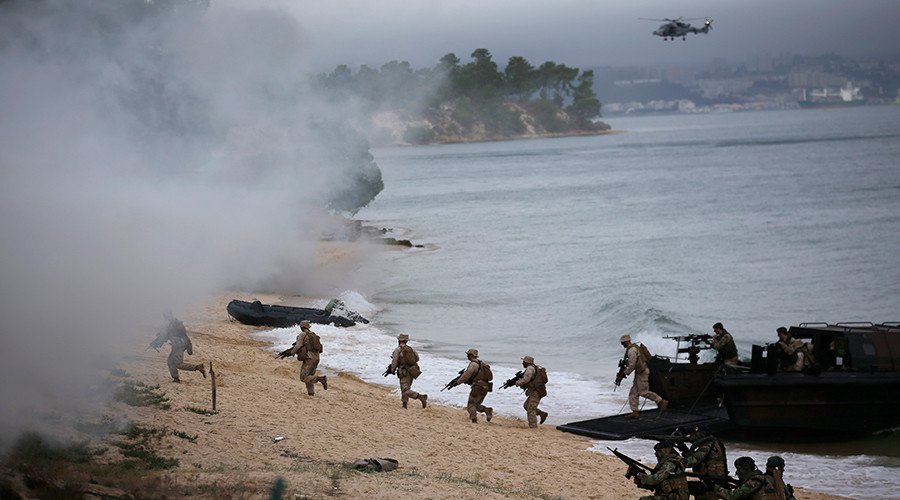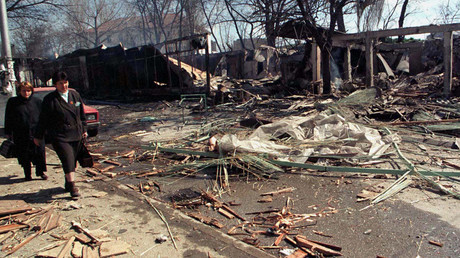
Geographically speaking, the country is a natural fortress, and could be held against an invading force by a much smaller number of defenders, Thermopylae-style. That is precisely what the Montenegrin Army did at Mojkovac in 1916, protecting the flank of the retreating Serbian Army against a numerically superior Austro-Hungarian force.
 RT
Επαληθευμένος λογαριασμός
RT
Επαληθευμένος λογαριασμός

Then there is the symbolism part. Back in the 15th century, even after they successfully overran the Serbian principalities of the central Balkans and advanced on Vienna, the Ottoman Turks found that they could never fully subjugate the mountain clans of Montenegro. After trying many times and failing, they settled for exacting tribute instead. This enabled the small Orthodox Serb community to preserve their faith, culture and memories – until their statehood could be resurrected in the 1800s. The Prince-Bishops of Montenegro were a loyal ally of Imperial Russia, to the point of declaring war on Japan in 1904 in solidarity with the Tsar.
Montenegro united with Serbia in 1918, and soon thereafter became part of the Kingdom of South Slavs, later known as Yugoslavia. It stayed in the union with Serbia even after Yugoslavia was dismembered by the EU and NATO in the early 1990s. It, too, was bombed by NATO airplanes in 1999, when the Alliance attacked Yugoslavia in support of the ethnic Albanian separatists in Kosovo. When NATO sought to drive a wedge between Serbia and Montenegro by sparing the latter, the following graffiti appeared in the city of Niksic: “Bomb us too, we’re not lepers.”
Yet the leader of Montenegro, Milo Djukanovic, decided to switch allegiances after that war. Having come to power in 1989 as a fierce supporter of union with Serbia, he reinvented himself a decade later into the biggest anti-Serb in the former Yugoslavia, a fairly daunting task.
Djukanovic aided the US-backed activists in their October 2000 coup that seized power in Belgrade, arguing that Montenegro’s suddenly-discovered problems with Serbia were due to a deficit of democracy. Within months, however, he was campaigning for independence. NATO and the EU were happy to oblige. They first negotiated an agreement between Montenegro and Serbia, abolishing the very name of Yugoslavia and proclaiming a “State Union.” Within three years, right on script, Djukanovic called a referendum on independence.
A video surfaced of Djukanovic agents openly buying votes, persuading people to “break their minds” and vote yes. Tens of thousands of Montenegrins living in Serbia were disenfranchised, while buses and charter jets of ‘Bosnians’ and ‘Kosovars’ were brought in. On May 21, 2006, the separatists won by fewer than 2,000 votes, or 0.5 percent. The US-controlled government of Serbia shrugged and accepted the outcome.
Djukanovic proceeded to turn Montenegro into a virulently anti-Serb society, establishing a new “Orthodox Church,” proclaiming a new language, and essentially redacting all mention of the country’s Serb identity from history books and literature. The crowning achievement of this ‘identity change’ would be membership in NATO and the EU.
The regime in Belgrade, which oscillates madly between practical submission to NATO and gestures of eternal friendship towards Russia, doesn’t appear too concerned about Montenegro’s membership in the aggressive military bloc. Neither, for that matter, does Moscow.
“This is their personal matter, it’s their personal choice. It’s up to them to decide on this. If they think that this will benefit their national security, then this is so,” is how Yevgeny Lukyanov, Deputy Secretary of Russian Security Council, commented on Montenegro’s NATO membership to reporters on Monday, according to TASS.
Is it? So, one supposes, was the choice faced by Regent-Prince Pavle Karadjordjevic of Yugoslavia in March 1941, when Hitler and Mussolini pressured him to join the Tripartite Pact, promising safety in the Axis rear. Traumatized by the bloodbath of WW1, his government signed the pact, only to be overthrown in a coup two days later. The enraged Hitler – who needed the Balkans pacified before he could launch his invasion of the Soviet Union – ordered Yugoslavia “wiped off the map,” postponing Operation Barbarossa from mid-May to late June. The end of that particular story was commemorated on May 9 – though hardly by any NATO members, one should note.
Yugoslavia was literally decimated, and the USSR lost almost 27 million people fighting the Nazis, only for the modern map of Europe to look eerily like it did in 1942. Many of Hitler’s allies then are NATO members now, and German troops are once again in artillery range of Leningrad (now called St. Petersburg). Having secured Montenegro and expecting no resistance from “softly” occupied Serbia, NATO may be emboldened to act even more aggressively towards Russia. This is madness, of course, but there is an alarming lack of sanity in Brussels and Washington these days.
That is why Montenegro matters.
Nebojsa Malic for RT






